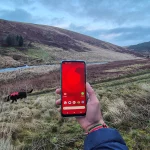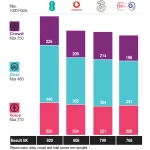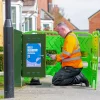Full Fibre Rollout to Remote Fair Isle Sets New Openreach Record

Openreach (BT) has announced that they’ve managed to bring their gigabit Fibre-to-the-Premises (FTTP) based broadband ISP network to the remote Fair Isle, which is a tiny island that sits around halfway between Shetland and the Orkney islands (Scotland) – the longest distance (100km) they’ve been able to transmit a continuous fibre signal anywhere in the UK.
The deployment itself formed part of the Scottish Government’s £600m Reaching 100% (R100) project, which among other things also enabled the deployment of a new subsea fibre link to help connect the remote rural community.
The new fibre optic cable starts its journey at a central distribution point (headend) in the Lerwick Exchange on Shetland and then passes through a specialised signal Repeater, in Sumburgh, 37km away, which amplifies the light signal. This in turn allows the signal to travel on to its destination on the Fair Isle, more than 75km away, using the aforementioned subsea fibre cable.
Advertisement
Once ashore, the fibre is then connected into a Sub-tended Headend (SHE) which in turn boosts the optical signal out into the community, providing all 51 occupied premises on the island with access to “ultrafast speeds” (despite the language, Opereach’s site states that gigabit speeds are available) – marking a huge improvement over the speeds of c. 0.5Mbps that were previously possible (although Starlink also became an option in 2023).
The term Subtended Head End is a bit of a mouthful, but they’re essentially mini exchanges (aka – mini-head end or mini-Optical Line Terminals [OLT]) that can be installed closer to customers inside new or existing street cabinets). The first pilot deployments of these began all the way back in 2019 (here) and they’ve since been expanded. Such builds avoid the need for disruptive traffic management (fewer civil works) and are thus more cost-effective.
Fraser Rowberry, Openreach Chief Engineer for Scotland, said:
“Regular fibre signals just couldn’t go the distance, so we had to get creative with some world first engineering to transmit life-changing ultrafast broadband over 100 kilometres to islanders. We had to do everything differently on Fair Isle, from planning around bird nesting seasons to setting up flat-packed cabins for our crew.
A big shout-out to the people of Fair Isle for being so welcoming to our team. They’ve been amazing. Now, they’re connected to the world in a whole new way. This will make Fair Isle an even better place to be – for residents, visitors and future generations – and we’d encourage people on the island to upgrade to full fibre.”
Wellbeing Economy Secretary, Neil Gray, said:
“I am delighted that we have achieved digital connectivity for Fair Isle almost two years earlier than planned. Through our R100 commitment to tackle some of the hardest to access terrain in the country, we are improving the educational and life opportunities available to young people across Scotland. This innovative step forward for engineering ensures children on Fair Isle are not left behind.
Internet speeds rivalling the best in the country are helping create a more attractive place for families and young people to live.
We committed to invest further in our digital connectivity, despite powers being reserved to Westminster, because we know that by supporting remote working and rural businesses – from Fair Isle jumpers to tourism – we can help to build an island economy which is fair, green and prosperous.”
A post office and shop are among the businesses which are already connected, and all premises on the island can now order the service. Installations also had to be carefully planned on the National Trust for Scotland-protected island, which is home to rare nesting birds and contains habitats of scientific and conservation value.
Mark is a professional technology writer, IT consultant and computer engineer from Dorset (England), he also founded ISPreview in 1999 and enjoys analysing the latest telecoms and broadband developments. Find me on X (Twitter), Mastodon, Facebook, BlueSky, Threads.net and Linkedin.
« Mayor of London Ponders Single FREE Open Access WiFi Network
FTTP Rollout is a Golden Opportunity to Improve UK Home WiFi »























































World first? 🙂
I avoided the “world” part and only mentioned it as being a first for Openreach itself, since I couldn’t verify that any of that was truly a “world” first.
Well I guess it’s a world first for Openreach on the Fair Isle 🙂
Maybe they meant “first world engineering”!
“world first engineering”? Not really. Submarine cables with repeaters routinely reach spans of thousands of kilometers.
But good that Fair Isle has decent connectivity at last!
I think its the 1st time a subtended headend has been used a repeater
It’s an OLT connected via a repeater.
Might be a first as no way this kinda expense is happening without serious taxpayer subsidy. No remotely sane commercial case for it. The fibre being used was part of a taxpayer subsidised programme, as was the remote OLT and fibre to premises.
Just the beginning of these insanely expensive builds to reach the most remote clusters of properties.
Missed out a bit: the actual connection between the remote and the OLT parenting it isn’t interesting. It’s going to be ‘simple’ Ethernet, not PON.
The remote OLTs are doing what the FTTC DSLAMs did: terminating customer connections and sending them over Ethernet to OLTs but via 10 Gbit Ethernet rather than 1 Gbit. The OLTs already have the cards in them: they’re how CPs connect to the FTTP customer base.
I guess the deployment had to be done this way as it would be even more expensive to build out more equipment on the island so a long link to a remote was the only way and is more than enough.
Yes its very good that Fair Isle has got gigabit capability “at last” but the engineering is absolutely nothing special. Traditionally optical spans of 80Km are what OR build and that is what they have done here with a repeater inserted at Sumburgh to get the 112Km route broken into a 37Km and 75Km section. All very conventional stuff.Given that Fair Isle has only 51 premises I’d assume OR would backhaul them at 10Gbs and there are plenty of SFP+ optics available with ranges of up to 120Km, using those would have negated the need for the repeater. But perhaps they are looking to provide more than 10Gbs backhaul? If so there are also plenty of line optical systems with spans of 120Km with 100/200/400Gbs coherent modulations so still nothing clever about their solution. OR tends to be very conservative with its solutions and this is a good example. Nothing wrong with it, just nothing very clever either.
how many remote islands are B4RN covering, Bazza?
@Ivor – Depends on what you mean by islands! B4RN has done plenty of isolated hamlets and clusters of properties up long valleys that have meant driving the optical paths to 100Km and beyond. There are sections of over 120Km without amplification although those are 1Gbs rather than 10Gbs. The fact that part of the route is subsea just means a rather expensive laying operation rather than any technical challenge at the optical layer. The point I was trying to make was that its OR PR hype claiming a first for this sort of thing, its standard industry stuff well established. But its good to see R100 North coming onstream and many isolated island communities getting gigabit broadband. Well done Scottish Government and OR.
Now if they could just lay 100 metres on a perfectly normal housing estate from where it is available to mine…..
No headlines in doing that though.
(Well somebody had to – why not me ?)
If you pay them to as the Scottish Government are for this I am sure they’ll be happy to oblige 🙂
suggest you offer to bridge to the gap over and above the openreach commercial case they it might get done
I bet they could do the whole road not just my place for that.
No question and with a lot of change to spare. If you can get the Scottish Government to put up the cash between their normal costs and what it will cost to dig your street, sounds like digging is needed, then all will be good.
Dear sir i am interested